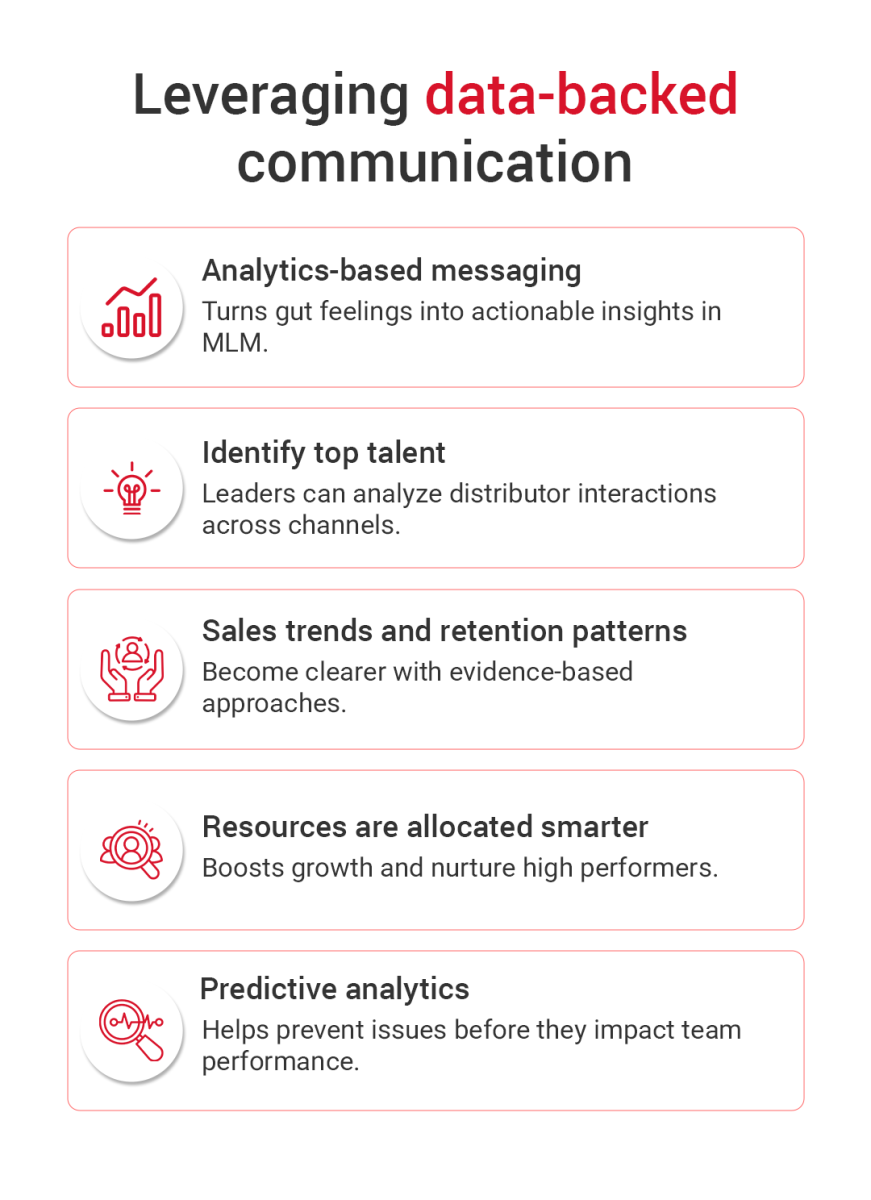Most MLM companies face one constant obstacle, i.e., ensuring their communication is transparent, standardized, and accessible to all. Due to rapid regional expansion and workforce growth, important updates, education material and customer service information may accidentally fall through the cracks. When such communication gaps occur, distributors become easily misaligned, causing a slowdown in the company's growth. In order to address this challenge, today’s MLM companies are seeking to introduce new modes of communication—designing modern systems to link their teams and inform and engage all.
The solution to traditional communication delays
The traditional way of MLM communication used a top-down flow of information, which is rapidly becoming obsolete. Nowadays, smarter communication tools are being adopted by the best MLM companies. These tools enable all participants to communicate freely without being bound by their rank in the compensation system.
In fact, this change in information distribution is not just about adopting new tools, it is an indication of a total renovation of traditional network marketing activities. With the help of instant communication, distributors positioned in various regions can now work together to share essential market intelligence as well as consumer data that previously would have never left its own chain.
Successful distributors understand that such platforms motivate them to become aggregators of information, not just transmitters. By identifying key roles to play in these networks, they tremendously increase their influence beyond the status/title they hold within the firm.
The role of omnichannel integration
MLM communication strategies in modern MLM software are not about merely arranging video conferences and sending out email newsletters. The use of multiple platforms, each with their own purpose, allows for a well-supported communications structure that suits the needs of distributors at every point in entrepreneurial growth.
Asynchronous distributor training facilitated by online portals ensures team members can learn important content at times that fit best with their personal availability. These systems take into account that the typical "everyone at a set time" schedule does not consider the flexibility in direct selling, which attracts people to this field in the first place.
In the same way, making micro-learning modules available through mobile apps lets distributors benefit from small pockets of otherwise wasted time. With this strategy, companies accept that MLM entrepreneurs are usually developing their ventures within the confines of busy personal schedules.
The latest development in the industry is contextual communication, which provides exactly the relevant information a distributor requires at different points in their activity. These platforms offer training and help at the right moment, which greatly accelerates the training of new team members.
Benefits of data-driven communication
Even though relationship-building is essential in the field of network marketing, today’s top MLM earners enhance their interpersonal skills using detailed data analysis. Combining communication methods with analytical data converts informal perceptions into practical decision-making information.

Attentive team leaders are now able to spot which distributors hold leadership potential, which goods are most successful among particular markets, and which training possibilities support the greatest retention by closely examining interactions on multiple channels.
A key advance in modern network marketing consists in replacing intuitive communication with approaches grounded in evidence. Implementing these systems empowers organizations to channel resources where they will have the greatest impact on growth and the development of top performers.
Also, integrating predictive analytics into these platforms gives team leaders the opportunity to spot upcoming problems and take action to avoid growth problems. This approach is very different from the mostly reactive approaches employed by network marketing organizations before.
Making use of cross-functional collaboration
The long-standing use of sponsorship lines as the main basis for information sharing has systematically constrained sales force creativity in the MLM sector. Modern means of communication make it possible for distributors to work together across established boundaries, enabling them to assemble into communities united by their interests, experience, or market segments.
Through the collaboration of distributors across functional boundaries in arenas like social media, customer service, and product learning, organizations establish hubs of best practices to the advantage of the entire enterprise. Bringing experts from diverse sponsorship lineages together helps companies to foster innovative systems that speed up the creation and communication of best practices.
The most innovative organizations set up digital spaces for collaboration that allow distributors to share knowledge resources larger than their own teams. Organizations gain an enhanced return on distributor experience by allowing individual insights to be transformed into organizational assets through these systems.
Multimedia communication
Text-based exchanges have traditionally reigned in digital spaces. But modern multimedia methods are growing in prominence, as they more closely fit the updated ways people process information. Constructing messages using a blend of audio, visual, and interactive solutions supports enhanced brain activity and supports more effective learning outcomes.
Advanced multi-level marketing enterprises now offer diversified media platforms that consist of podcasts for use during daily travel, video libraries for those who learn best visually, and interactive simulations for skill improvement. These multiple formats take into account different ways in which distributors learn and give them several methods to achieve expertise.
The fact that user-generated content is now a main feature of these systems highlights an important change. Allowing distributors to share insights in many media formats enables companies to foster more authentic communication that surpasses the effect of corporate materials alone.
Discover how we build resilient businesses with advanced MLM functionalities
AI-enhanced communication: The next milestone
AI’s integration into MLM communication networks brings a future of targeted support for individual distributors. AI technology analyzes huge amounts of interaction data to find patterns and generate customized recommendations that manual work cannot achieve.
A number of advanced AI systems deploy virtual coaching platforms, which review interactions between distributors and their clients to provide private improvement feedback and automated content engines. This offers suitable resources to distributors based on their progress, and anticipatory tools designed to predict the best time to reach out to prospects.
A key characteristic of organizations leading this new trend is their use of combined AI and human expertise systems, making possible greater scale in delivering personalized communication. The use of these systems increases both the scale and impact of top performers by distributing their expertise through technology-driven channels.
Key takeaways
Organizations involved in MLM will thrive in the years ahead if they make smarter communication systems as the foundation of their operations. Such organizations know that information quality is foundational for the efficient operation of all functions, including recruiting, training, selling, and developing future leaders.
The ability to master these contemporary communication approaches has the potential to offer individual distributors their strongest competitive edge in the current marketplace. Those who understand and exploit these complex information systems, by gathering useful ideas, adding value with shared content, and joining separate groups, are likely to carry the highest prestige in direct selling organizations.
Ambitious MLM entrepreneurs in this context are judged not by their place in the hierarchy, but by their ability to use advanced communication systems to increase their network-wide impact.









Leave your comment
Fill up and remark your valuable comment.